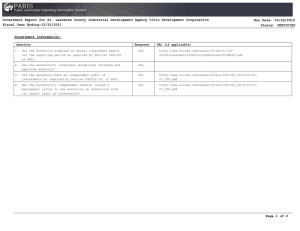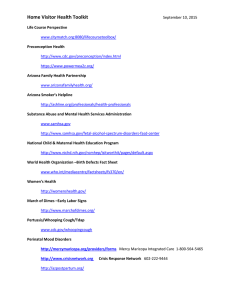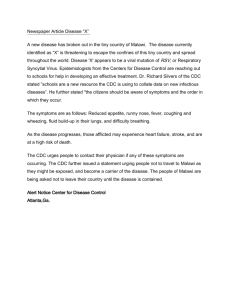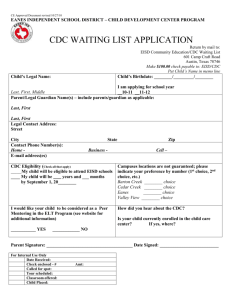07-ID-06 Committee: Title: Statement of the Problem:
advertisement
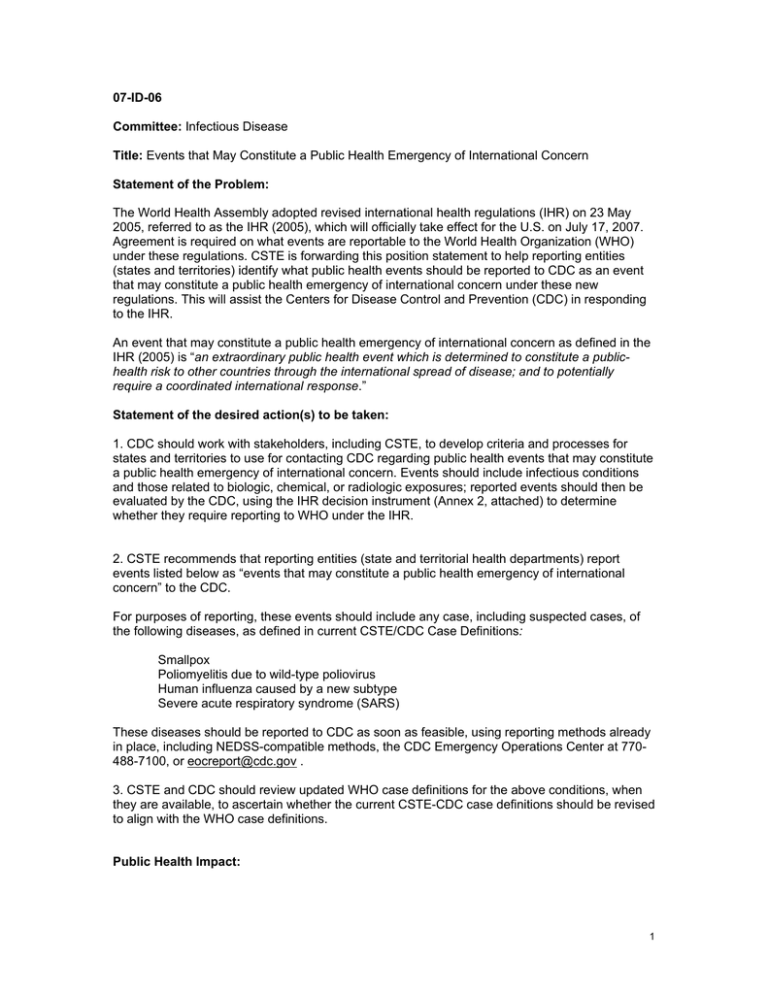
07-ID-06 Committee: Infectious Disease Title: Events that May Constitute a Public Health Emergency of International Concern Statement of the Problem: The World Health Assembly adopted revised international health regulations (IHR) on 23 May 2005, referred to as the IHR (2005), which will officially take effect for the U.S. on July 17, 2007. Agreement is required on what events are reportable to the World Health Organization (WHO) under these regulations. CSTE is forwarding this position statement to help reporting entities (states and territories) identify what public health events should be reported to CDC as an event that may constitute a public health emergency of international concern under these new regulations. This will assist the Centers for Disease Control and Prevention (CDC) in responding to the IHR. An event that may constitute a public health emergency of international concern as defined in the IHR (2005) is “an extraordinary public health event which is determined to constitute a publichealth risk to other countries through the international spread of disease; and to potentially require a coordinated international response.” Statement of the desired action(s) to be taken: 1. CDC should work with stakeholders, including CSTE, to develop criteria and processes for states and territories to use for contacting CDC regarding public health events that may constitute a public health emergency of international concern. Events should include infectious conditions and those related to biologic, chemical, or radiologic exposures; reported events should then be evaluated by the CDC, using the IHR decision instrument (Annex 2, attached) to determine whether they require reporting to WHO under the IHR. 2. CSTE recommends that reporting entities (state and territorial health departments) report events listed below as “events that may constitute a public health emergency of international concern” to the CDC. For purposes of reporting, these events should include any case, including suspected cases, of the following diseases, as defined in current CSTE/CDC Case Definitions: Smallpox Poliomyelitis due to wild-type poliovirus Human influenza caused by a new subtype Severe acute respiratory syndrome (SARS) These diseases should be reported to CDC as soon as feasible, using reporting methods already in place, including NEDSS-compatible methods, the CDC Emergency Operations Center at 770488-7100, or eocreport@cdc.gov . 3. CSTE and CDC should review updated WHO case definitions for the above conditions, when they are available, to ascertain whether the current CSTE-CDC case definitions should be revised to align with the WHO case definitions. Public Health Impact: 1 Rapid reporting of these events to CDC are designed to allow CDC and WHO prevent and provide protection against exposures to diseases and other health threats and the international spread of diseases while minimizing interference with world travel and trade. 2 Coordination: Agencies for Response: Julie Gerberding, MD, MPH Director Centers for Disease Control and Prevention 1600 Clifton Road NE M/S D14 Atlanta, GA 30333 404-639-7000 jyg2@cdc.gov Agencies for Information: Scott J. Becker Executive Director Association of Public Health Laboratories 8515 Georgia Avenue, Suite 700 Silver Spring, MD 20910 Telephone: 240-485-2745 ext 201 Fax: 240-485-2700 sbecker@aphl.org Paul E. Jarris, MD, MBA Executive Director Association of State and Territorial Health Officials 2231 Crystal Drive Suite 450 Arlington, VA 22202 Phone: (202) 371-9090 Fax: (571) 527-3189 pjarris@astho.org Submitting Author: Christine Hahn, MD State Epidemiologist Idaho Department of Health and Welfare, Division of Health 450 W. State St 4th floor Boise, ID, 83702 208-334-5939 hahnc@dhw.idaho.gov Co-Authors: Gilberto F. Chave, MD State Epidemiologist California Department of Health Services 1616 Capitol Ave, Suite 74.321 Sacramento, CA 95899-7413 916-440-7434 gchavez1@dhs.ca.gov 3 Steven C Macdonald Surveillance Epidemiologist Washington State Dept. of Health Office of Epidemiology PO Box 47812 Olympia WA 98504 360-236-4253 steven.macdonald@doh.wa.gov 4 50 FIFTY-EIGHTH WORLD HEALTH ASSEMBLY ANNEX 2 DECISION INSTRUMENT FOR THE ASSESSMENT AND NOTIFICATION OF EVENTS THAT MAY CONSTITUTE A PUBLIC HEALTH EMERGENCY OF INTERNATIONAL CONCERN Events detected by national surveillance system (see Annex 1) A case of the following diseases is unusual or unexpected and may have serious public health impact, and thus shall be notifieda, b: Smallpox Poliomyelitis due to wild-type poliovirus Human influenza caused by a new subtype - Severe acute respiratory syndrome (SARS). Any event of potential international public health concern, including those of unknown causes or sources and those involving other events or diseases than those listed in the box on the left and the box on the right shall lead to utilization of the algorithm. OR OR Is the public health impact of the event serious? No Yes Is the event unusual or unexpected? Is the event unusual or unexpected? No Yes No Yes Is there a significant risk of international spread? Yes An event involving the following diseases shall always lead to utilization of the algorithm, because they have demonstrated the ability to cause serious public health impact and to spread rapidly internationallyb: Cholera Pneumonic plague Yellow fever Viral haemorrhagic fevers (Ebola, Lassa, Marburg) West Nile fever - Other diseases that are of special national or regional concern, e.g. dengue fever, Rift Valley fever, and meningococcal disease. Is there a significant risk of international spread? No Yes No Is there a significant risk of international travel or trade restrictions? Yes No Not notified at this stage. Reassess when more information becomes available. EVENT SHALL BE NOTIFIED TO WHO UNDER THE INTERNATIONAL HEALTH REGULATIONS a b As per WHO case definitions. The disease list shall be used only for the purposes of these Regulations. RESOLUTIONS AND DECISIONS 51 EXAMPLES FOR THE APPLICATION OF THE DECISION INSTRUMENT FOR THE ASSESSMENT AND NOTIFICATION OF EVENTS THAT MAY CONSTITUTE A PUBLIC HEALTH EMERGENCY OF INTERNATIONAL CONCERN The examples appearing in this Annex are not binding and are for indicative guidance purposes to assist in the interpretation of the decision instrument criteria. DOES THE EVENT MEET AT LEAST TWO OF THE FOLLOWING CRITERIA? I. Is the public health impact of the event serious? 1. Is the number of cases and/or number of deaths for this type of event large for the given place, time or population? 2. Has the event the potential to have a high public health impact? THE FOLLOWING ARE EXAMPLES OF CIRCUMSTANCES THAT CONTRIBUTE TO HIGH PUBLIC HEALTH IMPACT: Is the public health impact of the event serious? 9 Event caused by a pathogen with high potential to cause epidemic (infectiousness of the agent, high case fatality, multiple transmission routes or healthy carrier). 9 Indication of treatment failure (new or emerging antibiotic resistance, vaccine failure, antidote resistance or failure). 9 Event represents a significant public health risk even if no or very few human cases have yet been identified. 9 Cases reported among health staff. 9 The population at risk is especially vulnerable (refugees, low level of immunization, children, elderly, low immunity, undernourished, etc.). 9 Concomitant factors that may hinder or delay the public health response (natural catastrophes, armed conflicts, unfavourable weather conditions, multiple foci in the State Party). 9 Event in an area with high population density. 9 Spread of toxic, infectious or otherwise hazardous materials that may be occurring naturally or otherwise that has contaminated or has the potential to contaminate a population and/or a large geographical area. 3. Is external assistance needed to detect, investigate, respond and control the current event, or prevent new cases? THE FOLLOWING ARE EXAMPLES OF WHEN ASSISTANCE MAY BE REQUIRED: 9 Inadequate human, financial, material or technical resources – in particular: – Insufficient laboratory or epidemiological capacity to investigate the event (equipment, personnel, financial resources) – Insufficient antidotes, drugs and/or vaccine and/or protective equipment, decontamination equipment, or supportive equipment to cover estimated needs – Existing surveillance system is inadequate to detect new cases in a timely manner. IS THE PUBLIC HEALTH IMPACT OF THE EVENT SERIOUS? Answer “yes” if you have answered “yes” to questions 1, 2 or 3 above. 52 FIFTY-EIGHTH WORLD HEALTH ASSEMBLY II. Is the event unusual or unexpected? Is the event unusual or unexpected? 4. Is the event unusual? THE FOLLOWING ARE EXAMPLES OF UNUSUAL EVENTS: 9 The event is caused by an unknown agent or the source, vehicle, route of transmission is unusual or unknown. 9 Evolution of cases more severe than expected (including morbidity or case-fatality) or with unusual symptoms. 9 Occurrence of the event itself unusual for the area, season or population. 5. Is the event unexpected from a public health perspective? THE FOLLOWING ARE EXAMPLES OF UNEXPECTED EVENTS: 9 Event caused by a disease/agent that had already been eliminated or eradicated from the State Party or not previously reported. IS THE EVENT UNUSUAL OR UNEXPECTED? Answer “yes” if you have answered “yes” to questions 4 or 5 above. III. Is there a significant risk of international spread? Is there a significant risk of international spread? 6. Is there evidence of an epidemiological link to similar events in other States? 7. Is there any factor that should alert us to the potential for cross border movement of the agent, vehicle or host? THE FOLLOWING ARE EXAMPLES OF CIRCUMSTANCES THAT MAY PREDISPOSE TO INTERNATIONAL SPREAD: 9 Where there is evidence of local spread, an index case (or other linked cases) with a history within the previous month of: – international travel (or time equivalent to the incubation period if the pathogen is known) – participation in an international gathering (pilgrimage, sports event, conference, etc.) – close contact with an international traveller or a highly mobile population. 9 Event caused by an environmental contamination that has the potential to spread across international borders. 9 Event in an area of intense international traffic with limited capacity for sanitary control or environmental detection or decontamination. IS THERE A SIGNIFICANT RISK OF INTERNATIONAL SPREAD? Answer “yes” if you have answered “yes” to questions 6 or 7 above. RESOLUTIONS AND DECISIONS 53 Risk of international restrictions? IV. Is there a significant risk of international travel or trade restrictions? 8. Have similar events in the past resulted in international restriction on trade and/or travel? 9. Is the source suspected or known to be a food product, water or any other goods that might be contaminated that has been exported/imported to/from other States? 10. Has the event occurred in association with an international gathering or in an area of intense international tourism? 11. Has the event caused requests for more information by foreign officials or international media? IS THERE A SIGNIFICANT RISK OF INTERNATIONAL TRADE OR TRAVEL RESTRICTIONS? Answer “yes” if you have answered “yes” to questions 8, 9, 10 or 11 above. States Parties that answer “yes” to the question whether the event meets any two of the four criteria (I-IV) above, shall notify WHO under Article 6 of the International Health Regulations.


